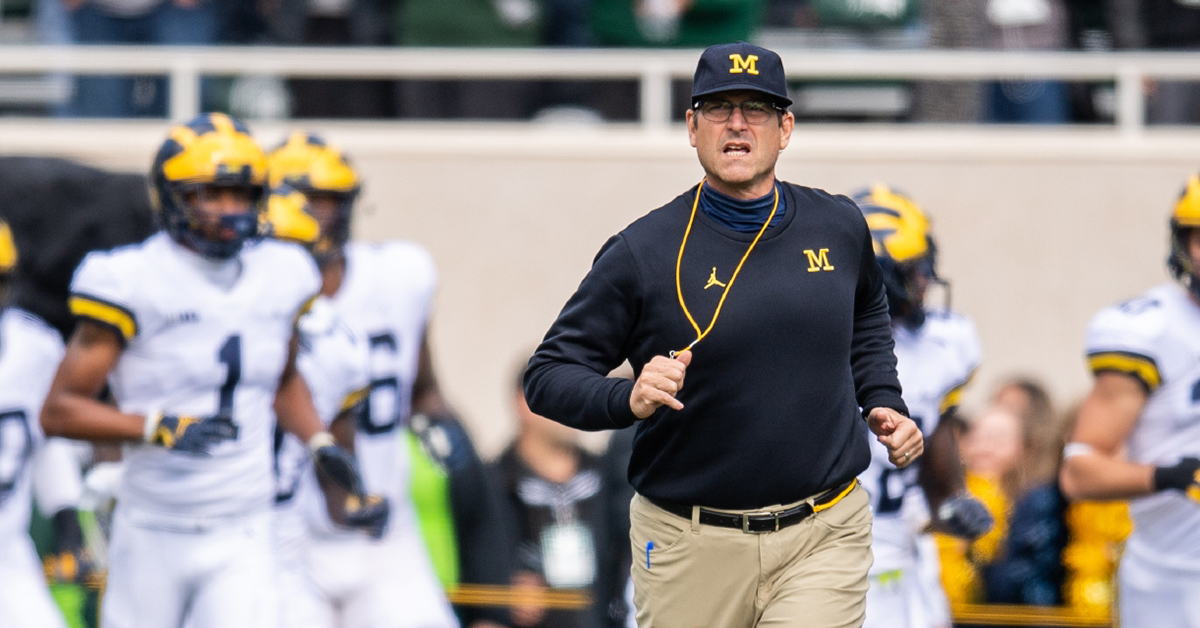College football season is here. With that, one question now reverberates around Ann Arbor: “Will this be the year that Michigan beats Ohio State?”
Author John U. Bacon, ’82, MA’94, is not ready to commit to victory, but he has high expectations for the 2019 U-M football squad, thanks to head coach Jim Harbaugh, ’86.
“This team is as lined up as any Jim has ever had,” Bacon says.
He should know. On Sept. 3, HarperCollins released his latest book, “Overtime: Jim Harbaugh and the Michigan Wolverines at the Crossroads of College Football.” It is Bacon’s fifth book about U-M football. His most recent, “Endzone: The Rise, Fall, and Return of Michigan Football,” was published in 2015. That book told the story of how the U-M football program disintegrated and how Harbaugh came back to his alma mater to revive it.
Plenty has happened since then, and Bacon covers it thoroughly in his new book, having received unprecedented access through the 2018 football season to Harbaugh’s coaches, players, and staffers, whether during closed-door meetings, meals, or classes.
It is not another Harbaugh biography or synopsis of U-M’s wins and losses, although “Overtime” has both of those elements. Rather, this book features stories about the football program’s newfound philosophy surrounding academics, the tasks performed by the team staff, and the role of parents in grooming and advising their sons. It also features a variety of stories from the players’ perspective.
Early in the book, Bacon writes, “Ask a Michigan football coach, staffer, player, or parent what outsiders don’t understand, and invariably, the first thing they say is, ‘No one has any idea how much work goes into this.’”
One particular focus of the book is on recruiting, detailed in the chapter titled “Hard to Beat the Cheaters.” Bacon believes the men on the field, as much as the win-loss record, will tell the story of the Harbaugh era.
“When people look back 10 years from now, they will ask, ‘Did he actually recruit top-level college players? Or can he say, ‘the deck was stacked against me?’” Bacon says. The author compares the recruiting approach of U-M and other Big Ten schools with that of the Southeastern Conference (SEC), which, he says, “makes no bones about focusing on football” rather than the broader athletic program.
The biggest contrast in the recruitment strategies of U-M and SEC schools is the practice of “over-signing,” in which a coach signs more recruits to national letters of intent than he has scholarships to hand out. Then he runs a tryout during August preseason camp and eliminates the lower players from contention.
U-M does it differently. Bacon outlines a five-step recruiting program that extends over a two-year cycle. The school casts a wide net, beginning with 4,900 names, each of whom gets at least a two-minute video review. U-M coaches then winnow the list down to 300 top prospects, compiling a 10-minute highlights reel of their best and worst plays.
From there, the list shrinks to about 150 names, and the team looks at factors like grades, school activities, and the role that parents play. Finally, there is the school visit.
U-M offers about 150 scholarships to get the 25 acceptances the school can give to football players in a given year. That ratio is far lower than many schools and varies by position—U-M generally offers six to eight scholarships to quarterbacks in order to yield one acceptance from the group.
Harbaugh has clear views on who should sign with U-M.
“If you want to make Michigan great, and make yourself great, this is a great place to be,” he tells Bacon. “The ones you have to oversell what we have to offer, you know it’s not going to work. If you don’t get the appeal of this program, of a Michigan education … well, I don’t know what to tell you. You’ll probably be happier somewhere else and maybe we will be too.”
As Bacon writes, Harbaugh is also responsible for a significant shift in how the University views athletes’ academic performance. U-M gives a lot of academic support to its players, who are expected to take a full load of classes during the football season. By 2018, upperclassmen were pursuing 31 different degree programs.
“If you want to make Michigan great, and make yourself great, this is a great place to be.”
While academics might matter to Harbaugh and his coaches, some fans care only about the outcome of each week’s game—and the Holy Grail of beating Ohio State and, beyond that, a Big Ten title and a spot in the national championship game. In August, Charles Woodson, ’x97, the 1997 Heisman Trophy winner, predicted the Wolverines would beat the Buckeyes this fall.
Whether or not that happens, Bacon says he wishes U-M fans would enjoy the team’s performance more and appreciate how “phenomenal” the program now is on “every level.”
But he understands why expectations are so high in 2019 for Harbaugh and the U-M program. Says Bacon, “The passion level here is so intense, which is usually a good thing. I’d rather have people care than not care.”
Micheline Maynard, a Knight Wallace Fellow in 1999-2000, is a regular contributor to Michigan Alumnus.





